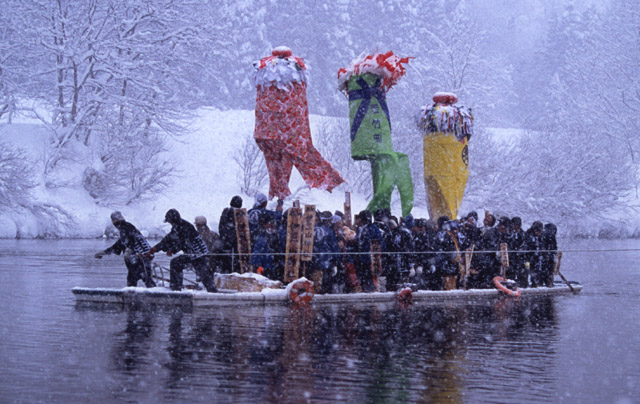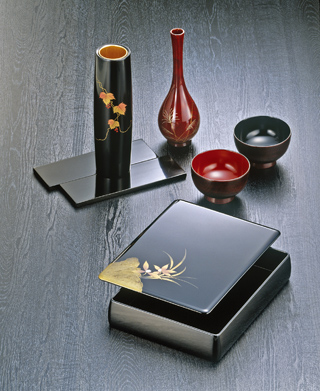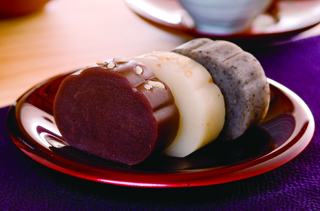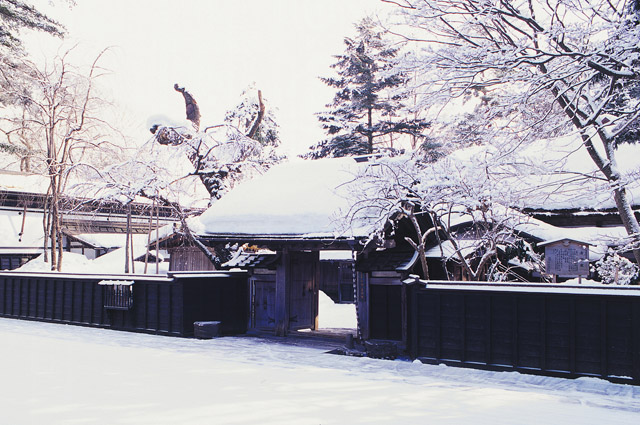Walk through the historic center of Kakunodate, where the low branches of weeping cherry trees hang quietly over the pitch black fences of the town’s old samurai manors. Dating from the late Edo Period, each of the remaining houses offers a unique glimpse into a long-gone era when the traditional arts flourished and the samurai had traded their swords for calligraphy brushes and tea bowls.
By Robert Morel
Explore the expansive grounds of the Aoyagi Manor, and admire the family’s private collection of samurai-era weapons and art. Stepping through the Ishiguro Manor’s main gate, past the spy hole–lined black fence, reveals the oldest and most austere of the town’s manors. Inside the wooded grove surrounding the Iwahashi Manor, admire a rare, 300-year-old oak tree and see how a typical middle-class samurai family lived. The Kawarada Manor gives visitors an opportunity to see a more distinct regional style of architecture of the north, while the Japanese gardens of the Odano Manor are perfect for a contemplative stroll. At the Matsumoto Manor, lucky visitors may get to see the traditional craft of itaya-zaiku—thin strips of maple being woven into fences—being carried out. Martial arts enthusiasts can visit the former Onozaki Manor, now an active dojo.
The outer town, once home to merchants and craftsmen, retains its historic air as well, with many of the old merchant houses given new lives as shops and cafés. Rickshaws take visitors through the wooded streets, and a local history guide association offers tours to delve deeper into the town’s history and culture. Established in 1620, Kakunodate’s layout has changed little during its 390-plus years of history. It is a history the town celebrates every autumn with a two-day festival nearly as old as the town itself.
Kawatsura Shikki—A Glaze Deep as Night
For roughly 800 years, the craftsmen of Yuzawa, in the mountains of southern Akita, have been honing the skill of turning simple boxes and bowls into works of art and beauty. One of the prefecture’s signature crafts, Kawatsura lacquerware’s deep black sheen and delicate gold relief designs transforms everyday objects into striking works of art.
Crafting a single piece of Kawatsura Shikki requires the utmost skill and care. Artisans first painstakingly apply thin layers of a delicate base coat, one after another, before carefully finishing with a shiny, oil-rich lacquer. Today, some artists such as Kou Sato of the Li-Zan workshop have launched a renaissance in the art form by combining modern design elements while staying true to eight centuries of traditional techniques. While Kawatsura Shikki is available in stores throughout the area, a trip to the workshops and galleries of Yuzawa offers a unique opportunity to see the artists at work as well as the diverse range and variety of these elegant crafts.
Angoma Mochi—A Layered Treat
For a unique northern take on Japan’s traditional sweet mochi rice cakes, visit the town of Hachirogata, just 40 minutes north of Akita city. The town is known for its Angoma Mochi. Like many mochi-based sweets,
it starts with soft, chewy base of pounded rice and is topped with a generous spread of sweet anko red bean paste. What sets it apart though is the thick top layer of deep black ground sesame. What seems like a minor change to one of Japan’s most ubiquitous sweets results in a surprising alteration of its flavor. In addition to giving the snack a little crunch, the rich umami of the sesame offsets and perfectly balances out the sweet bean paste. To try it for yourself, stop by Hatae-Kashiho, one of Hachirogata’s most popular Angoma Mochi shops.
Oga Kuro Shio—Crystals from the Sea
Akita has a long history of artistry that extends well beyond finished crafts and cuisine, down to the smallest of materials and ingredients. With its prize-winning, artisanal black sea salt, Oga Kobo upholds this tradition. Using only local water from the Japan Sea, Oga Kobo slowly evaporates the water in flat, heavy, meter-wide iron pans, leaving behind a light dusting of tiny black pyramid-shaped crystals. Because of the thorough, artisanal process, it takes nearly three tons of water to make just five small bottles of salt. The result of this meticulous process is a smooth, flavorful seasoning unlike anything in the supermarket. Lacking the metallic sharpness of mass-produced salt, Oga Kuro Shio is perfect for sprinkling over salads, fish, tempura, and a range of other dishes.
Yamakyu Shoyu—Artisanal Soy Sauce
While Akita’s Kodama Brewing is best known for its range of quality sake, the brewery got its start making batches of dark soy sauce. Since its beginnings in 1879 Kodama has continued to produce its signature Yamakyu Shoyu using traditional methods and quality ingredients. While it seems like the simplest of ingredients, like Oga Kobo’s black salt, Yamakyu Shoyu is made with such care and attention to detail that it stands apart from ordinary soy sauce. In 1985 the brewery became the first private company to receive the Imperial Prize for a product, and had been a frequent winner of prizes by the Ministry of Agriculture. While foodies will certainly appreciate the difference in flavor, thanks to Yamakyu Shoyu’s long and lauded history a simple bottle of soy sauce can even become a set piece for dinnertime conversation.
Whether it be old samurai manors and gardens, traditional crafts, sweets, or even the seemingly simplest of seasonings, Akita’s attention to detail and craft show through in all of its traditional processes.
Main image: Participants in the Bonten Matsuri transport brightly colored baskets across the Omono River, in a festival that takes place on February 11.
Updated On December 26, 2022












